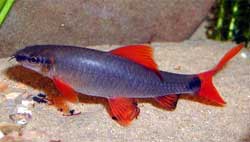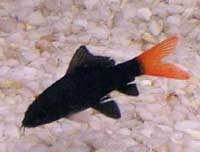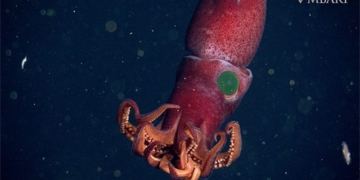 Known as “shark fish” due to their aggressive nature and long dorsal fin that resembles a miniature shark, these fish are called Labeo bicolor. Their bodies are predominantly black, with a bright red tail, and they can grow up to a maximum length of 12 cm.
Known as “shark fish” due to their aggressive nature and long dorsal fin that resembles a miniature shark, these fish are called Labeo bicolor. Their bodies are predominantly black, with a bright red tail, and they can grow up to a maximum length of 12 cm.
Despite their small size, they exhibit remarkable bravery when facing larger fish of different species. They can be even more aggressive towards their own kind. Each red-tailed shark has its own territory, which is typically a specific area within a fast-flowing stream. They relentlessly chase and bite any intruders (as long as the intruders are not significantly larger than themselves).
To survive in fast-moving waters, the red-tailed shark possesses unique adaptations. They have a suction pad located on their lower jaw, which allows them to cling tightly to rocks or tree trunks. The red-tailed shark is also a strong swimmer, capable of swimming continuously against strong currents. However, they sometimes seek shelter in areas with relatively gentle water flow.
 The eggs of the Labeo bicolor have a very strong adhesive quality. When the female lays her eggs, she quickly attaches them to submerged tree trunks. Interestingly, the fry are capable of clinging tightly to tree trunks or rocks immediately after hatching. Soon after, the fry are able to swim and withstand the strong currents.
The eggs of the Labeo bicolor have a very strong adhesive quality. When the female lays her eggs, she quickly attaches them to submerged tree trunks. Interestingly, the fry are capable of clinging tightly to tree trunks or rocks immediately after hatching. Soon after, the fry are able to swim and withstand the strong currents.
This species prefers to live near the bottom of the water. They feed on algae and small plants that they scrape off rocks or tree trunks. They are also willing to eat worms, crustaceans, and small insects whenever the opportunity arises.
Red-tailed sharks are abundant in Thailand, where they are often caught and kept as ornamental fish. Generally, with such aggressive fish, it is difficult to keep two males in the same tank, as they will fight each other and incur serious injuries. Interestingly, when three or four males or even more are placed in the same tank, they tend to be less aggressive towards one another.



















































